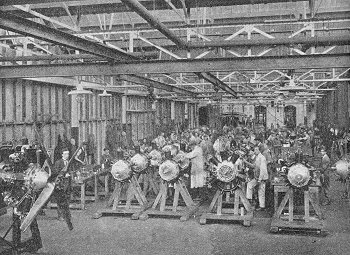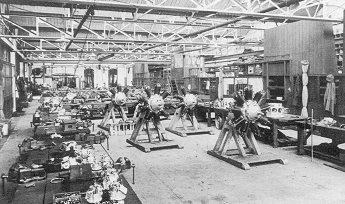Clyno
Large numbers of aircraft were built during the first world
war and so a correspondingly large number of engines were needed. In June
1918 the War Department required nearly 65,000 engines.

The interior of the Clyno works, showing the
assembly of the Dragonfly engines. Courtesy of the late Jim Boulton. |
The largest single requirement was for 8,580 ABC
Dragonfly engines. The Dragonfly had nine cylinders, weighed only 600lb,
and could deliver 365h.p. Orders were sent to companies all over the
country including Clyno Engineering and Guy Motors in Wolverhampton.
Early in 1918, Clyno received an order for 8 prototype engines and 500
production engines. Work on the engines quickly got under way and the
first engine was delivered on 22nd April 1918, followed by another in
June. |
| By the end of the year, 6 of the prototype engines and 4
of the production engines had been completed. The final two prototypes
were delivered early in 1919, along with 47 production engines. The
other 453 were cancelled. The orders came too late in the day, because
the war soon ended, and the Ministry cancelled all outstanding
items. |

Another view showing Dragonfly assembly at Clyno. |
Much of the design
work was carried out by Arthur G. Booth.
Read a paper that was given by him and view some of his Clyno
photographs |
 |
Guy Motors
Sidney Guy left Sunbeam in 1914 to start Guy Motors. The
company, which was formed in May 1914, built light commercial vehicles. A
new factory was built at Park Lane and the first product was a 30cwt lorry,
with a light pressed steel frame, special patented suspension and overdrive.
The company also produced a light mail car. At the beginning of the first
world war, the Ministry of Munitions took over the factory for military
production, and Guy became the largest manufacturer of depth charge firing
mechanisms. Early in 1918, the company started to produce aero-engines. On
19th April, Guy received an order for 12 experimental ABC Wasp engines,
which were designed by Granville Bradshaw, who used to work for Star. He
designed Star's monoplane and flew the aircraft at Dunstall Park. Guy also
received an order for a single experimental ABC Dragonfly radial engine, on
12th April. Production quickly got under way and Guy received a further
order for 600 Dragonfly engines. It took the company only 24 days to
complete their first engine. They were congratulated by the Director General
of Aircraft Production and Supply, William Weir. At the end of the war, all
outstanding orders were cancelled by the Ministry. Before cancellation, Guy
managed to deliver 1 Dragonfly and 12 Wasp engines. The company received
£65,000 in compensation for the cancelled order. Before the end of the war
Guy began development of a V12, liquid cooled aero engine, but this was also
cancelled after the war.
H. M. Hobson Ltd / Lucas
Aerospace
|

|
|
Find out about Hobson's |
Goodyear
The Goodyear Tyre & Rubber Company came to Wolverhampton in
1927. Its Aviation Division made tyres, wheels and brakes for aircraft. It
also produced an anti-skid braking system. Its products were fitted to many
aircraft including the Viscount, the Herald, the Carvair, and the
Accountant.
Marston-Palmer Limited
This is a small group of aerospace manufacturers, including
Lucas Aerospace, Turners, and Dowty Aerospace. Its products are aircraft
heat exchangers and engine rings. It also makes hydraulic components and
aircraft bulk liquid storage facilities.
Turner Manufacturing
In 1934 Turners acquired a license to manufacture German
designed hydraulic and pneumatic undercarriages. It soon began to produce
undercarriages of its own design, and these were built in large numbers
during the second world war. It also made tail wheels for Lancasters and
Blenheims. After the war Turners returned to making car components. In the
1950's the company made parts for the Rolls Royce Dart engine, and rotor
heads, tail rotors and undercarriages for Westland helicopters. The company
was taken over by the Spicer Transmission Division and still makes aircraft
components.

|
Return to
the Aircraft Section |
|



